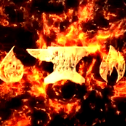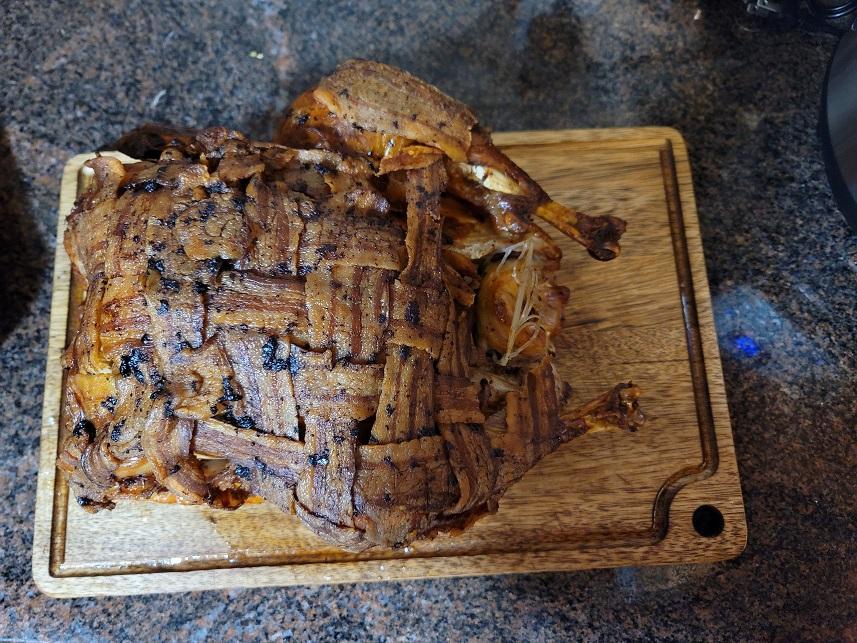-
Posts
1,403 -
Joined
-
Last visited
Content Type
Profiles
Forums
Articles
Gallery
Downloads
Events
Everything posted by Frazer
-

What did you do in the shop today?
Frazer replied to Mark Ling's topic in Blacksmithing, General Discussion
You have a huge asset (perhaps that's not the best word, but for the sake of brevity I'll use it anyway) having John locally. Once you get to that stage I'm sure he would be happy to give you some tips. It's said around here often, but there is sometimes, IMHO, an unnecessary mystique or perceived difficulty around forge welding. It's a process involving a proper forge environment, sufficient heat, appropriate pressure (aka whacking) and avoiding that urge (especially in the early stages) to whack it "just one more time". Of course you have to get a decent grasp on some of the other fundamentals first, but having someone there to help while you're getting your legs under you will save you a lot of trial and error, especially when welding. I hope you have some nice weather and are able to get into the shop. -

What did you do in the shop today?
Frazer replied to Mark Ling's topic in Blacksmithing, General Discussion
I used fullering dies in my guillotine tool, but a spring/gate fuller would do just as well. Depth controlled with heat and hammer control. It's easy enough to do by eye. I like the tree, very festive. Do you think ferric chloride would etch it any better? -

What did you do in the shop today?
Frazer replied to Mark Ling's topic in Blacksmithing, General Discussion
Oh, and practice.. Lots of practice. You may want to try an easier weld to start, just to make sure your forge can get up to the proper temperature. In other words, start with the poking end of the poker, then work on your baskets, then work on joining the two. Start with practice pieces. On your final one you wont open up the basket until after it's been joined with the longer bar. There are lot's of handle options for your practice pokers. Here's one I did a little while ago with 1/2" sq bar. -

What did you do in the shop today?
Frazer replied to Mark Ling's topic in Blacksmithing, General Discussion
Jennifer's videos and some consultation (in this very thread IIRC) is how I learned. Here's the link to her channel, just search basket twist in there. I believe there are 3 videos on them. https://www.youtube.com/channel/UC8WRbArfgi8kSaDek7kh_1Q -

Isn't "The Great Resignation" just Baby boomers retiring?
Frazer replied to rockstar.esq's topic in Everything Else
I'm on the younger end of millennials. What's interesting about my age group 1995 ± a couple years is we were the first group of people who grew up (more or less) surrounded by screens. I think there is some debate as to whether this change was primarily a good or a bad thing. However, I don't think you can debate the fact that the change has had -- and will continue to have -- a major effect on how people behave, interact and develop. So while each generation does tend to dwell on the "failings" of the next, I'm inclined to believe that there was a more significant change between later-Millennials/Gen Z and all of the previous generations. Perhaps it's my age and I'm feeling the same "lamentations" you (or your parents) felt. It's certainly not the first major cultural or technocultural (sic) shift we've seen. However, this time it's different ....*semi-ironic tone*. My younger cousins were trying to get me to do their TicToks at a family gathering last night.. I just don't understand what is so darn interesting about dancing and making kissy faces for hearts (likes are hearts) on the internet.. Meanwhile I'm teaching my niece how to text Abc on my brick phone.. Back to the original question, I think George sums it up well. I'll just add that at work a lot of people retired (some early, some "on time") during covid due to changes in the work environment and/or insecurity around their 401k's/the stock market. A recent article might be using retirement data from the last year or two, which could be an outlier in the overall trend. Without seeing the article I can only speculate. In another 20-40 years the same thing will probably be said about Millennials. Even if they leave the workforce temporarily, they'll have to come back eventually. -

What did you do in the shop today?
Frazer replied to Mark Ling's topic in Blacksmithing, General Discussion
Jennifer, I like that handle a lot. I've said it before, but I'll say it again, I love that anvil.. -

Fifty Pound Chain two man hammer
Frazer replied to Boppa George Curley's topic in Blacksmithing, General Discussion
That or it has a file format that isn't supported. If it isn't already, try saving it as a .jpeg or .png file and resizing. Also, welcome aboard! If you haven't already Read this First. -

What did you do in the shop today?
Frazer replied to Mark Ling's topic in Blacksmithing, General Discussion
It is tough stuff. Work it hot (not too hot) and stop at orange. You'll feel it stiffen up and (if you listen real close) possibly start laughing at your hammer around that temperature. Once you're done forging, heat it up to bright orange and bury in vermiculite. After it's cool then do your grinding. Slowly reheat to ~1900F (bright orange) and air cool. I was surprised by how hot it's hardening temperature is, but even with the low tech blacksmith method it does work. -
I understand that. He could make the hammer, punch and drift from 1045 with less of the hassle of playing with tool steels. That's what we did over the weekend. I have several H13 tools, and a few others that are S7. You have years of experience... Would you give a someone bar of either one to make his (I presume) first hammer eye punch?
-
H13 can be a little finicky to harden too. I've had reasonable success at the home shop, but it's nearly impossible to do it "by the book" without an oven. It's great steel for tools, but from an ease of use/forging perspective it's certainly not for the faint of heart. I also wouldn't make a hammer out of H13.
-
Heat up the boss/rivet area and then work them open and closed a bit, they'll loosen up. Some of thee store bought tongs are made from cast and/or MC steel so I wouldn't quench them. Just them slow cool, maybe a dunk in oil at a lower heat for lubrication purposes. You shouldn't need to do that if you buy tongs, but the rivet might have just been a little tight from the factory. Should be easy enough to smooth out.
-
Keep at it, it will click. Have a clean fire, get it hot enough, once it drops below a welding heat stop hitting it.
-
One thing I've learned with respect to blacksmithing is that its not a sprint, it's a marathon. A bit of a cliche perhaps, but it's true. You can try to sprint to the finish line, but there's a 99.9+% chance you'll just tire yourself out and give up. That, or you'll slow down, find your rhythm and cruise your way there. Your friend is at the first peak of the Dunning-Kruger Effect. Perfectly normal. I wanted to make Damascus knives and swords when I first started. Now, not so much..
-
Make him him do a leaf key chain or a bottle opener first. Your forge your rules . Then ask him if he still wants to make an axe right off the bat. If he does then he still needs to make the tools to be able to attempt such a project. If you already have then, tell him he has to make his own. It's part of the process. Other than that, there are many, many projects that involve slitting/drifting and/or welding. Obviously some of them are easier than others. If you're going to get yourself on track to make an axe, start small. Take a ball peen hammer and turn it into a small tomahawk. Half the work is already done for you there. Hm... Steve Wells.... Wells.. is that H.G.'s brother? *grin*
-
1095 (and many other alloys), yes. AR400 (and many other alloys), no. Technically AR400 isn't a specific alloy. I believe different manufacturers have different specs for the composition. Like TP mentioned, quench a test piece of approximately the same cross section before you quench the axes. Also, you would want to normalize not anneal.
-

Should I get a training anvil for blacksmithing?
Frazer replied to SupaConducta's topic in Anvils, Swage Blocks, and Mandrels
No problem, happens all the time. -

Should I get a training anvil for blacksmithing?
Frazer replied to SupaConducta's topic in Anvils, Swage Blocks, and Mandrels
That's Frazer, with z. -

Should I get a training anvil for blacksmithing?
Frazer replied to SupaConducta's topic in Anvils, Swage Blocks, and Mandrels
Here you go. https://www.iforgeiron.com/topic/52308-a-collection-of-improvised-anvils/ I used a piece of steel from the scrapyard when I was first starting. I beat the daylights out of it while learning hammer control. Start with the basics and buy new tools when you have a better grasp on what you need and what you don't. -

What did you do in the shop today?
Frazer replied to Mark Ling's topic in Blacksmithing, General Discussion
Chad, tongs are looking pretty good! On the next pair, knock down those edges on the handles for a "softer" feel in the hand. On this pair it's probably easier to use a file since they are already bent. -
Geding, here is one of Alexandr's more recent posts. https://www.iforgeiron.com/topic/66519-what-did-you-do-in-the-shop-today/?do=findComment&comment=752766
-

What tools do you use the most?
Frazer replied to Glenn's topic in Blacksmithing, General Discussion
The things I use the most I keep in my pockets or have attached to my anvil stand: soapstone, scribe, silver pencil, ruler, tong clips, chisel, mini "pocket" tongs, hardy, anvil block guillotine and brush. I guess that translates to an apron or coveralls with extra pockets and an anvil stand with tool holders. I also always have a calculator, a steno notebook and a pencil on the workbench. -
-
Sneaking it in last minute. Happy Thanksgiving everyone. I got to host this year and thus had bird duties (yes bird duties, ha-ha). Naturally, I went with a bacon weave turkey. It was delicious.
-
Very, very nice work. Hat's off to you sir.
- 4 replies
-
- photo heavy
- sword
-
(and 1 more)
Tagged with:
-

Issue with marks in the blade
Frazer replied to Yann Kastell's topic in Knife making Class General Class Discussion
So it seems like you're left with option 1 or 2 (or some combination of the two). Even if it isn't as flat as you originally planned I wouldn't call it a total loss. I've never tried to make a knife that long, but I doubt they all turn out how you originally planned. Especially when you're just starting out. What kind of steel is it made of? What's your plan for hardening and tempering?

